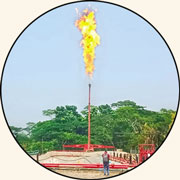
Promises made on energy turn hollow
Syed Mansur Hashim | Saturday, 3 August 2024
 Sadly, the power situation in the country has gone from bad to worse since Covid-19. While the pandemic has come and gone, the energy crisis refuses to go away. While policymakers keep raising tariffs on the promise of steady supply of requisite energy to industry and retail consumers, the assurances have turned hollow and the economy as a whole continues to suffer. Loss of production has led to factory closure causing ultimately unemployment and lower economic growth. A bleak future thus stares in the face of Bangladesh because the supply of energy, i.e. the bulk of fossil fuels that power our industry and power plants have become import-dependent.
Sadly, the power situation in the country has gone from bad to worse since Covid-19. While the pandemic has come and gone, the energy crisis refuses to go away. While policymakers keep raising tariffs on the promise of steady supply of requisite energy to industry and retail consumers, the assurances have turned hollow and the economy as a whole continues to suffer. Loss of production has led to factory closure causing ultimately unemployment and lower economic growth. A bleak future thus stares in the face of Bangladesh because the supply of energy, i.e. the bulk of fossil fuels that power our industry and power plants have become import-dependent.
Is it not ironic that the country has become overwhelmingly dependent on the whims of foreign energy markets, while significant reserves of natural gas remain unexplored in the country? What has compelled the government to turn a blind eye to several surveys done by international companies about potential gas reserves that are available onshore and which can be made available with acceptable levels of investments? Why is there no enthusiasm on exploring and extracting own reserves of energy? Frankly, it is easier to fleece consumers ---industrial or otherwise---by importing coal, oil and liquefied natural gas (LNG) because the country is a captive market. The government is the sole provider of energy and there are no competitors, unlike the situation in some other countries in the region where state-owned enterprises compete with private ones to sell energy to industry.
Getting back to the crisis in hand, there simply isn't enough energy to go round. Domestic gas is depleting at a fast rate and the import of all types of fossil fuels is hamstrung by a shortage of foreign exchange. There is no way that economic development can continue in a situation where there is a dearth of both energy and power for industry. While the readymade apparel sector (RMG) contributes about 80-85 per cent of the export earning, other important industrial sectors have developed too and also require energy. Though there have been arguments that fertiliser can always be imported and there is no need to keep supplying gas to old, gas-guzzling fertiliser factories, the situation has changed over time with the retirement of old factories and introduction of new ones that are more energy-efficient. Besides, fertiliser is an essential agricultural input that cannot be left to the whims of foreign market fluctuations - both pricewise and availability. Moving on from fertiliser, hundreds of billions of Taka have been poured into the ceramic industry and the country boasts a vibrant sector that practically serves the entire demand of the country. The Achilles heel is that it is entirely gas-run. So, this sector with massive export potential is also facing mothballs in the near future.
What the government isn't telling bulk and retail consumers is that the situation is not going to improve before 2030. Let's look at some facts on the ground. While it is difficult to measure exact demand, the general consensus is that it is hovering around 4,000 MMCFD (million cubic feet per day) and as per published data, supply of the gas on July 13-14 was 2,600 MMCFD. According to media reports, "Of this, the contribution of imported LNG was 604 MMCFD. The production from local gas fields was 1,996 MMCFD. Of these 1,209 MMCFD gas came from gas fields operated by international oil companies. Bibiyana Gas field operated by Chevron alone supplied 996 MMCFD. The current recoverable reserve of the field has depleted below 1.0 TCF" (trillion cubic feet). Again, according to a recent report published in Energy & Power Magazine, "installed generation capacity of grid connected power is 27,054MW (megawatt). Breakdown of this capacity is as follows: Gas-based: 11,180MW (43%), furnace oil: 6,035MW (22.30%), coal: 5,108MW (18.80%), hydroelectricity: 230MW (0.85%), grid-connected solar: 519MW (1.90%), and import: 2,656MW (9.80%)". The net result of all this "foreign" energy dependence is that Dhaka and other major urban centres suffered 2-3 hours of load shedding (while rest of the country suffered between 6 to 8 hours) during the hottest summer days of July.
Import-dependent energy supply is a recipe for disaster. This has long been brought to the notice by Bangladeshi energy experts and for long policymakers have ignored it. Simply because there is much opacity built in certain energy policies and hefty commissions can be paid to fatten the pockets of certain groups of people, the nation's energy security has been thrown out the window. This is the reality we live in today and the suffering has just begun.
mansur.thefinancialexpress@gmail.com